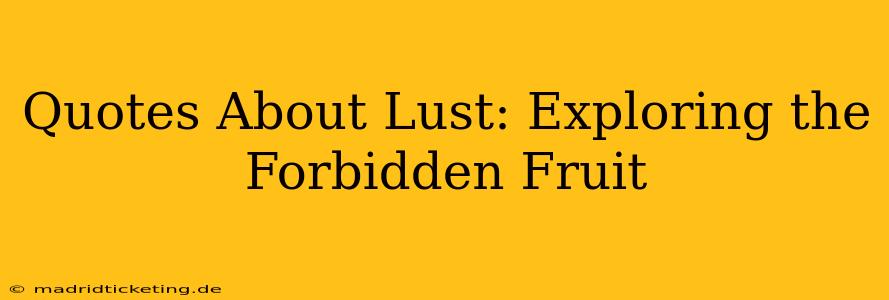Lust. A word that evokes a potent mix of exhilaration, danger, and undeniable human experience. From Shakespearean sonnets to modern poetry, lust has captivated artists and writers for centuries, inspiring some of the most evocative and memorable quotes in literature. This exploration delves into the multifaceted nature of lust, examining its portrayal across various mediums and answering some frequently asked questions surrounding this powerful emotion.
We'll explore famous quotes about lust, examining their context and the nuances they reveal about the human condition. We’ll also dissect the difference between lust and love, delve into the ethical considerations surrounding lust, and discuss its representation in art and literature. Prepare to embark on a journey into the heart of desire, exploring the forbidden fruit and its enduring allure.
What is the difference between lust and love?
This is perhaps the most frequently asked question surrounding lust. While both involve strong feelings, they differ significantly in their nature and intensity. Lust is primarily a physical attraction, a powerful craving for sensual gratification. It's often intense and immediate, fueled by the desire for physical intimacy. Love, on the other hand, is a much more complex emotion involving deep emotional connection, commitment, and care for another person's well-being. It's a slower burn, developing over time through shared experiences and mutual understanding. While lust can be a component of love, love is far more encompassing and enduring. Think of it this way: lust is the spark, while love is the sustained flame.
Are there any famous quotes about lust that capture its intensity?
Absolutely! Many famous quotes capture the raw intensity and urgency of lust. Shakespeare, as always, provides some potent examples. While not explicitly stating "lust," many of his sonnets allude to the overwhelming physical desire, highlighting its power to consume and transform:
- "Love looks not with the eyes, but with the mind, / And therefore is winged Cupid painted blind." While about love, this quote hints at the blindness and irrationality that can accompany strong lust. The focus shifts from rational judgment to overwhelming physical sensation.
Modern literature also offers compelling portrayals of lust's intensity. Think of the passionate encounters depicted in literature, where the urgency and raw energy of the physical attraction are vividly portrayed. These moments often underscore the overwhelming, almost primal nature of the experience.
What are the ethical considerations surrounding lust?
The ethical implications of lust are complex and often depend on context. Lust, when untempered by respect, consent, and consideration for others, can easily lead to exploitation and harm. Consent is paramount. Any sexual act without enthusiastic consent is unethical and potentially illegal. Beyond consent, the ethical dimensions also involve considerations of commitment, honesty, and the potential impact on relationships. Lust pursued recklessly can cause pain and damage to individuals and relationships. The ethical use of lust involves self-awareness, responsibility, and a deep respect for the autonomy and well-being of others.
How is lust represented in art and literature?
Lust's portrayal in art and literature is vast and varied. From the sensual sculptures of classical antiquity to the provocative paintings of the Renaissance and beyond, artists have used their mediums to explore the physical beauty and allure of the human form, often emphasizing the intensity of lustful desire. Literature, similarly, employs vivid descriptions and evocative language to convey the passion, urgency, and sometimes even the destructive power of lust. The representation often changes depending on the historical and cultural context, reflecting societal attitudes and beliefs towards sexuality and desire.
Is lust always negative?
Not necessarily. While unchecked lust can be destructive, it's not inherently negative. Lust, as a natural human drive, can be a source of pleasure and connection when approached responsibly and ethically. It can be a powerful motivator for intimacy and connection within committed relationships, adding a vibrant and passionate dimension to love. The key is balance and respect. When managed responsibly, it can be a positive force. However, it’s crucial to remember that lust should never override consent, respect, and ethical considerations.
In conclusion, lust is a powerful and complex human emotion, and its portrayal in quotes, art, and literature reflects its multifaceted nature. While it carries potential for both positive and negative consequences, understanding its nuances and ethical implications is crucial for navigating its complexities responsibly. The exploration of this "forbidden fruit" continues to fascinate and challenge us, reminding us of the enduring power of human desire.

